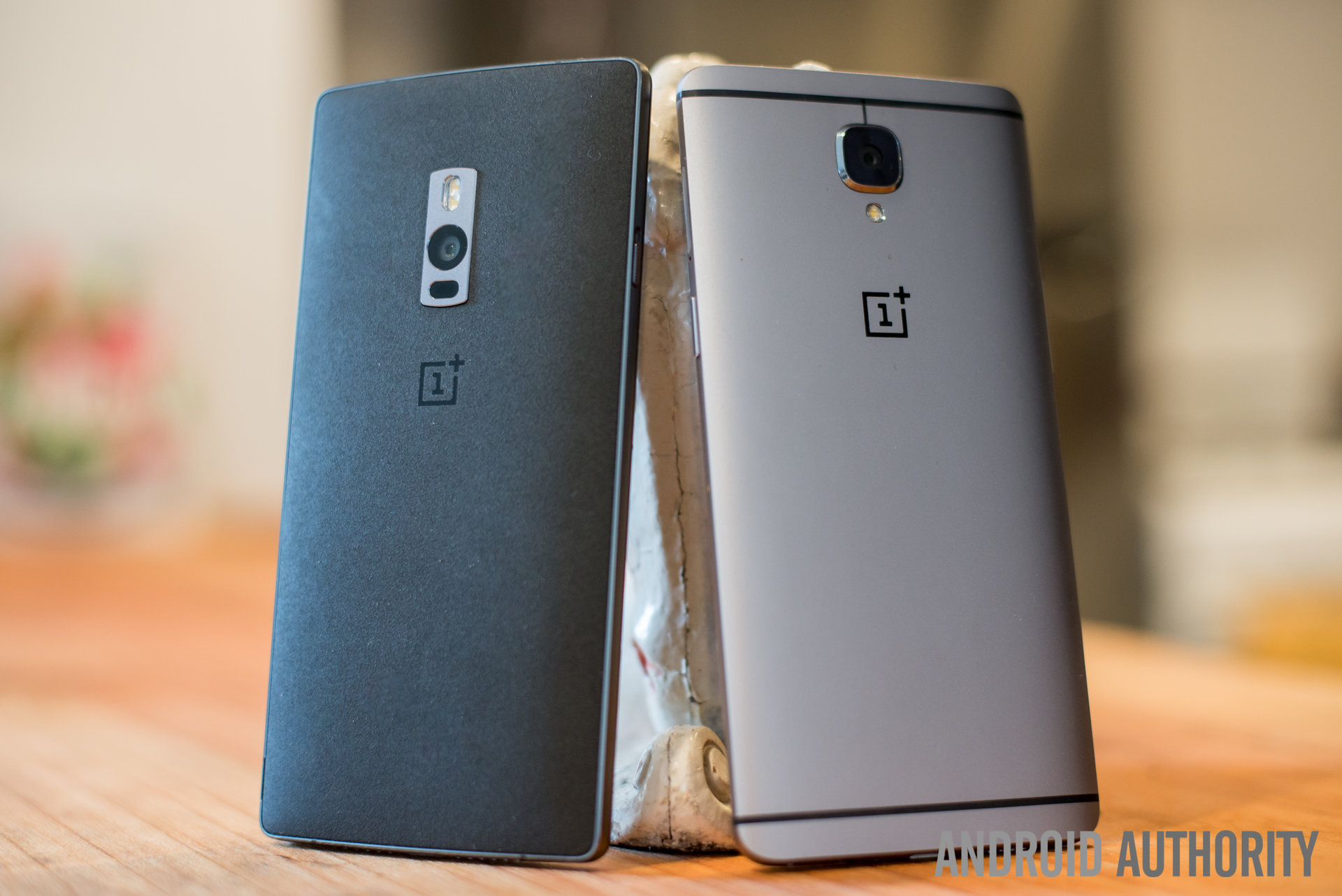Affiliate links on Android Authority may earn us a commission. Learn more.
Flagship spec showdown: OnePlus 3 vs the competition

OnePlus is back with its third attempt at a flagship killing smartphone, which is rather predictably, and still oddly, named as the OnePlus 3. Priced at just $399, the OnePlus 3’s cost certainly undercuts a lot of the leading handsets out there, but let’s take a closer look at the company’s hardware to see if this phone is really worth stumping up the cash for. In this article, we’ll be comparing the paper specifications of the OnePlus 3 against the new flagship Moto Z Force, the HTC 10, Samsung’s Galaxy S7, and the LG G5.
- OnePlus 3 review
- OnePlus 3 announced: everything you need to know
- OnePlus 3 vs OnePlus 2 quick look
- What would you change about the OnePlus 3?
We’ll start with the nuts and bolts of today’s smartphones – the processing package. After an assortment of processing options last year, Qualcomm’s latest Snapdragon 820 processor has once again become the ubiquitous chip of choice among flagship smartphone manufacturers. That said, Samsung’s Exynos 8890 powered Galaxy S7 is available in Europe and Asia.
| OnePlus 3 | Moto Z Force | Galaxy S7 | LG G5 | HTC 10 | |
|---|---|---|---|---|---|
Display | OnePlus 3 5.5-inch AMOLED 1920x1080, 401ppi | Moto Z Force 5.5-inch AMOLED 2560x1440, 535ppi | Galaxy S7 5.1-inch AMOLED 2560x1440, 577ppi | LG G5 5.3-inch :CD 2560x1440, 554ppi | HTC 10 5.2-inch LCD 2560x1440, 565ppi |
SoC | OnePlus 3 Snapdragon 820 | Moto Z Force Snapdragon 820 | Galaxy S7 Snapdragon 820 | LG G5 Snapdragon 820 | HTC 10 Snapdragon 820 |
CPU | OnePlus 3 2x Kryo @ 2.15GHz 2x Kryo @ 1.6GHZ | Moto Z Force 2x Kryo @ 2.15GHz 2x Kryo @ 1.6GHZ | Galaxy S7 2x Kryo @ 2.15GHz 2x Kryo @ 1.6GHZ | LG G5 2x Kryo @ 2.15GHz 2x Kryo @ 1.6GHZ | HTC 10 2x Kryo @ 2.15GHz 2x Kryo @ 1.6GHZ |
GPU | OnePlus 3 Adreno 530 | Moto Z Force Adreno 530 | Galaxy S7 Adreno 530 | LG G5 Adreno 530 | HTC 10 Adreno 530 |
RAM | OnePlus 3 6GB | Moto Z Force 4GB | Galaxy S7 4GB | LG G5 4GB | HTC 10 4GB |
Memory | OnePlus 3 64GB | Moto Z Force 32/64GB | Galaxy S7 32/64GB | LG G5 32GB | HTC 10 32/64GB |
MicroSD? | OnePlus 3 No | Moto Z Force Yes | Galaxy S7 Yes | LG G5 Yes | HTC 10 Yes |
[related_videos title=”” align=”right” type=”custom” videos=”697734,686764,684693,679576″]Straight away, we can expect virtually identical CPU performance across all of these smartphones, which will provide silky smooth performance in general day to day tasks and more computationally expensive situations, such as high resolution video streaming and gaming. The Snapdragon 820 also features Qualcomm’s X12 LTE modem, so all of these smartphones can reach peak 4G LTE speeds of 600 Mbps download and pp to 150 Mbps UL, given an equally powered network connection.
Interestingly, OnePlus has decided to also offer 6GB RAM inside its third flagship, which eclipses the 4GB of RAM offered as standard across all of the other of this year’s flagships. However, 4GB of RAM is already plenty for mass multi-tasking in Android, and users are unlikely to notice any major performance enhancements by opting for the 6GB RAM model. Speaking of memory, the OnePlus 3 only comes with one internal memory option, 64GB, which is quite a bit of space. However, the lack of a microSD card slot, a feature included pretty much unanimously across the board of high end handsets this year, is missing from the OnePlus 3, which might be a deal breaker for those who require lots of storage for pictures, movies and music.
The OnePlus 3's display is behind the curve
However, the slightly lower display resolution should mean slightly better battery life and less graphical processing power required to push pixels to the display, resulting improved GPU performance and/or lower power consumption. Given the relatively small differences in image quality between 1080p and QHD displays at this size, this may be a trade-off that some consumers are willing to make, but it will also draw some fair criticisms.
There’s much more to displays than resolutions though, and AMOLED types, once the sole domain of Samsung, have now reached a number of difference manufacturers. The OnePlus 3, Moto Z Force, the Galaxy S7, and even the ZTE Axon 7 all feature AMOLED displays, which boast more vivid colors and superior contrast ratios over LCD panel types. Those who like the look of AMOLED panels now have much more choice, and the OnePlus 3 is one of them.

Moving on to camera technology, we are seeing a much more diverse range of image sensor setups than ever before. We can’t say a lot about the camera quality verses the opposition without taking the time to go hands on ourselves, but the OnePlus 3 doesn’t look quite as adventurous as some of the other options out there. The G5 remains the only option outside of the HUAWEI P9 to offer up a dual camera configuration this generation, while Samsung and HTChave opted for larger pixel sizes and better low light performance with their lower resolution 12 megapixel sensors. That being said, the OnePlus 3’s 16 megapixels sit comfortably in the middle of the range, and Sony’s IMX 298 has been put to good use in the Xiaomi Mi5 and HUAWEI Mate 8 previously, so paper specs seem promising if not bleeding edge.
The OnePlus 3 is a great option for selfie lovers
Extras are just as important in today’s market for high-end handsets. Optical image stabilization and phase detection or laser autofocus camera technologies have hit the mainstream this generation and it’s very positive to see that the OnePlus has managed to keep up in this regard. Optical image stabilization is certainly a key feature to look out for if you’re into shooting video with your phone, and it can also help to improve the look of low light pictures as well.
| OnePlus 3 | Moto Z Force | Galaxy S7 | LG G5 | HTC 10 | |
|---|---|---|---|---|---|
Cameras | OnePlus 3 16 MP, 1.12um rear, with PDAF and OIS 8MP, 1.4um front | Moto Z Force 21MP, 1.12um rear, with PDAF & OIS 5MP 1.4um front | Galaxy S7 12MP, 1.4um rear with PDAF & OIS 5MP front | LG G5 16MP + 8MP wide angle rear, with laser AF & OIS 8MP front | HTC 10 12MP, 1.55um rear with laser autofocus & OIS 5MP, 1.34um front with OIS |
NFC | OnePlus 3 Yes | Moto Z Force Yes | Galaxy S7 Yes | LG G5 Yes | HTC 10 Yes |
Fingerprint | OnePlus 3 Yes | Moto Z Force Yes | Galaxy S7 Yes | LG G5 Yes | HTC 10 Yes |
Fast Charging | OnePlus 3 Dash Charge | Moto Z Force Yes | Galaxy S7 Quick Charge 2.0 | LG G5 Quick Charge 3.0 | HTC 10 Quick Charge 3.0 |
Other Extras | OnePlus 3 USB Type-C, 24-bit audio | Moto Z Force Modular, USB Type-C, no 3.5mm audio, 24-bit audio | Galaxy S7 IP68 rating, 24-bit audio, wireless charging, Samsung Pay | LG G5 Modular design, 24-bit audio, USB Type-C | HTC 10 24-bit audio, USB Type-C |
Battery | OnePlus 3 3,000mAh | Moto Z Force 3,500mAh | Galaxy S7 3,000mAh | LG G5 2800mAh removable | HTC 10 3,000mah |
OS | OnePlus 3 6.0 Marshmallow | Moto Z Force 6.0 Marshmallow | Galaxy S7 6.0 Marshmallow | LG G5 6.0 Marshmallow | HTC 10 6.0 Marshmallow |
Dimensions | OnePlus 3 152.7 x 74.7 x 7.35mm | Moto Z Force 155.9 x 75.8 x 7mm | Galaxy S7 142.4 x 69.6 x 7.9mm | LG G5 149.4 x 73.9x 7.7mm | HTC 10 145.9 x 71.9 x 9mm |
Weight | OnePlus 3 158g | Moto Z Force 163g | Galaxy S7 152g | LG G5 159g | HTC 10 161g |
So far, there hasn’t been a huge amount to tell a lot of these smartphones apart, and the OnePlus 3 does a good job at matching most of the core flagship features that consumers have come to expect. However, once we begin looking at the extras available with some of these handsets, you can begin to see where the extra money is going in other phones.
OnePlus finally brought back NFC with the OnePlus 3
The OnePlus 3 also comes with a USB Type-C port for those who want to use the latest cables. However, this port has been causing some controversy over charging speeds and support for accessories. This time around, the OnePlus 3 features Dash Charge technology to more quickly charge up the phone as fast as many of its competitors. However, this means that the handset won’t be compatible with the wide range of Quick Charge 3.0 certified accessories already on the market.
OnePlus has also embraced the push towards higher quality build materials, having ditched the plastics and gone with a metal body, or an anodized aluminum unibody to be more specific. This offers up some serious competition to the HTC10, the only other metal phone on our list, and the Galaxy S7’s glass back. However, the same sacrifices have been made when it comes to a non-removable battery, leaving LG’s G5 as the only flagship still offering this feature. Still, the 3,000mAh cell is highly competitive with other handsets on the market, and none of these models should leave you wanting for battery life.
While most other flagships come with a bevy of extra hardware features, the OnePlus 3 falls behind on this front

If you’re looking for something a little more out there, then the modular designs of the LG G5 and the Moto X Force are certainly worth looking into. Both smartphones boast audio, battery, and camera accessories, among others, for those who want to augment a particular favorite feature of their handset. Although these extras will set you back additional cash, making these setups far more expensive than the OnePlus 3. Similarly, phones like the LG G5 or the HUAWEI P9 with their dual camera technology are offering something a little more unique for the photography enthusiasts out there. That being said, if none of these additional features appeal or are important to you, then you can certainly save a few pennies by opting for the OnePlus 3.
The OnePlus 3 doesn’t quite do enough to earn its place right at the cutting edge of smartphone technology. In this sense it’s really not going to challenge today’s very top end flagships for all their features, but that was never going to happen at this $400 price point anyway. However, those looking for a powerful handset without the unnecessary frills will likely find the OnePlus 3 very compelling, especially because of its cheaper price tag. For example, look at competent but relatively safe flagships, such as the HTC10 or the Xperia X Performance, and the OnePlus 3 certainly seems to offer a tremendous value proposition.
Where do you stand on the OnePlus 3? Does the handset do enough to earn its place among the best of this year’s smartphones, or is it missing out on some key innovations?